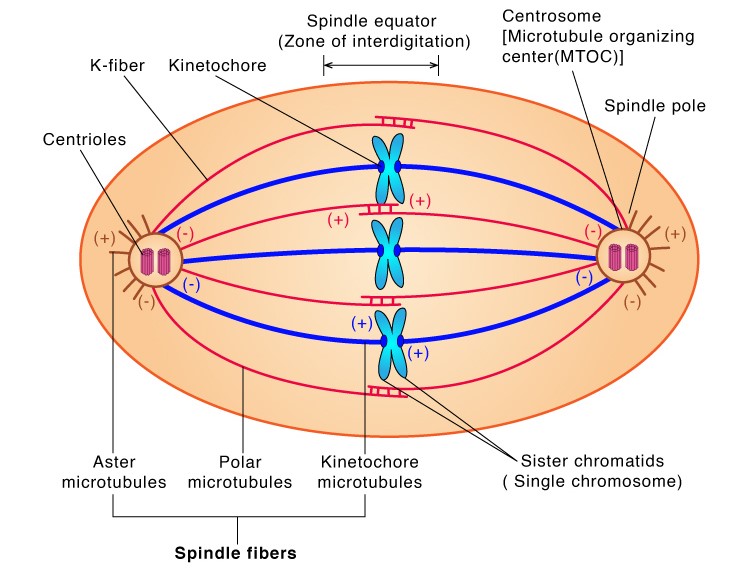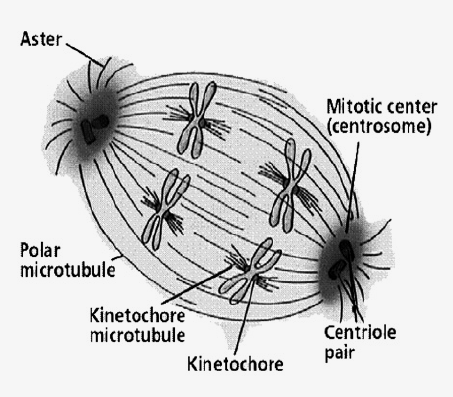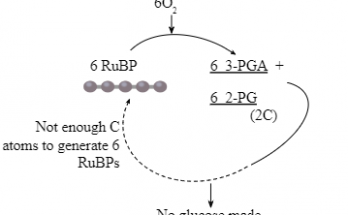Table of Contents
What are Spindle Fibres ?
Spindle Fibres are microtubules that play an important role in separating chromosomes during cell division. Spindle Fibres extend from the Centrosome and attach to the Chromosomes, pulling them apart during the process of mitosis or meiosis. Spindle Fibres also play a role in maintaining the shape and integrity of the cell during cell division. It ensures that each daughter cell receives the correct number of chromosomes.
Why are Spindle Fiber Important?
- Spindle Fibres are important as they are responsible for the proper segregation of chromosomes during cell division. Spindle Fibres play a crucial role in cell division by helping to separate the chromosomes during mitosis and meiosis.
- Spindle Fibres are made up of tubulin protein subunits and form a structure called the spindle apparatus. The Spindle Fibres attach to the chromosomes at specific regions called kinetochores and then exert force to pull the chromosomes apart during cell division.
- This ensures that each daughter cell receives a complete and accurate set of chromosomes, allowing for proper cell growth and development.
- Without Spindle Fibres chromosomes would not be properly segregate and that will lead to genetic abnormalities and cell death.
How are Spindle Fibres Formed?
- Spindle Fibres are formed in mitosis and meiosis through the activity of microtubules that extend from centrosomes to form the structure that separates chromosomes during cell division.
- Microtubules are cylindrical structures made up of the protein tubulin. In mitosis and meiosis, microtubules form a structure called the spindle apparatus.
- In mitosis Spindle Fibres form from the centrosomes. They are located at opposite ends of the cell. Centrosomes contain centrioles which are structures made of microtubules.
- Centrosomes begin to move apart when the cell enters mitosis. Microtubules extend from the centrioles to form the Spindle Fibres. These fibres then attach to the chromosomes that are lined up in the middle of the cell and pull them apart during cell division.
- In meiosis Spindle Fibres are formed from the centrosomes and from a structure called the meiotic spindle pole body.
- The meiotic spindle pole body is similar to the centrosomes but it is located in the cell’s cytoplasm instead of the cell’s poles.
- Microtubules extend from the centrosomes and the meiotic spindle pole body to form the Spindle Fibres.This then attach to the chromosomes and pull them apart during meiosis.
What are Spindle Fibres made up of?
- Spindle Fibres are complex structures made up of Microtubules, Centrosomes, Kinetochores and Motor proteins. All of this works together to ensure the proper segregation of chromosomes during cell division.
- Microtubules are long, cylindrical structures composed of the protein tubulin units. Microtubules are the building blocks of the Spindle Fibres and are arranged in a parallel array to form a bundle.
- Microtubule is composed of two types of tubulin subunits Alpha-tubulin and Beta-tubulin. Both of These subunits are arranged in a specific pattern. The Beta-tubulin subunit located on the outside of the Microtubule and the Alpha-Tubulin subunit located on the inside.
- Microtubules of the Spindle Fibres are dynamic structures which are constantly growing and shrinking through the addition and removal of tubulin subunits.
- This dynamic behaviour of Microtubule is essential for the proper functioning of Spindle Fibres during cell division.
- With microtubules, Spindle Fibres also contain other proteins such as centrosomes, kinetochores and motor proteins.
- Centrosomes are the microtubule organising centres that nucleate the microtubules of the Spindle Fibres.
- Kinetochores are protein complexes that are attached to the chromosomes and help to align them during cell division.
- Motor proteins, such as kinesin and dynein are responsible for the movement and organisation of the chromosomes during cell division.
Also Check – Mitosis In Plant Cell and Animal Cell- Differences and Similarities
Types of Spindle Fibres

There are 3 Important Types of Spindle Fibres they are as follows-
- Kinetochore fibres
- These are the types of Spindle Fibres that are attached to the kinetochore.
- Kinetochore is a protein structure located at the centromere of a chromosome.
- Kinetochore fibres play an important role in the proper segregation of chromosomes during cell division.
- It pulls the chromosomes apart during cell division and ensures that each daughter cell receives a complete set of chromosomes.
- Astral fibres
- These are the type of Spindle Fibres that extend outwards from the spindle poles and play a role in the proper alignment of chromosomes before cell division.
- Astral fibres interact with the cell’s microtubules and actin filaments to ensure that chromosomes are correctly positioned before they are pulled apart during cell division.
- Polar fibres
- These are the types of Spindle Fibres that extend from the spindle poles and play an important role in maintaining the shape and stability of the spindle fiber during cell division.
- Polar fibres are responsible for keeping the spindle poles in place and preventing the spindle from collapsing.
- Polar fiber also helps to ensure that the chromosomes are properly aligned before they are separated during cell division.
Also Check – 7 Important Difference Between Mitosis and Meiosis
Spindle Fibres in Mitosis
Spindle Fibres in Mitosis
Spindle Fibres are responsible for pulling the chromosomes to opposite ends of the cell during mitosis. Spindle Fibres are involved in maintaining the proper alignment of the chromosomes during cell division.It ensures that each daughter cell receives an identical set of chromosomes. Spindle Fibres are dynamic and constantly remodelling during mitosis.Their proper functioning is essential for the proper segregation of chromosomes and the formation of two genetically identical daughter cells.
Role of Spindle Fibres in Mitosis
The Spindle Fibres play a crucial role in the proper separation and distribution of chromosomes during mitosis, ensuring that each daughter cell receives a complete and accurate copy of the genetic material.
During the early stages of mitosis Spindle Fibres begin to form at opposite ends of the cell, known as the poles. These fibres then extend towards the center of the cell, where they will eventually connect to the chromosomes.
The Spindle Fibres are responsible for pulling the chromosomes apart during mitosis, separating the identical copies of each chromosome so that one copy can be distributed to each daughter cell.
Step By step Explanation of the role of Spindle fibre in each phase of Mitosis
During mitosis, the Spindle Fibres play a crucial role in the separation and distribution of chromosomes to the daughter cells. Spindle Fibres are microtubules that form a structure known as the spindle apparatus, which is responsible for the movement and alignment of chromosomes during mitosis.
Spindle Fiber during Prophase
- In Prophase Spindle Fibres begin to form and attach to the chromosomes at the kinetochores, which are specialised protein structures located at the centromere of each chromosome.
- The Spindle Fibres then begin to pull the chromosomes apart, aligning them at the metaphase plate, which is the centre of the cell.
Spindle Fibre during Metaphase
- In metaphase Spindle Fibres continue to pull the chromosomes towards the centre of the cell. It ensures that they are properly aligned and ready for separation.
- Once the chromosomes are properly aligned the Spindle Fibres begin to shorten and start pulling the chromosomes apart and separating them into the two daughter cells.
Spindle Fiber during Anaphase
- In Anaphase Spindle Fibres continue to shorten, pulling the chromosomes further apart and it ensures that they are properly separated into the two daughter cells.
- This process is called the Anaphase spindle pull. It is essential for the proper segregation of chromosomes.
Spindle Fiber during Telophase
- In telophase, the Spindle Fibres begin to disintegrate. The chromosomes begin to decondense and form the nuclei of the two daughter cells.
Spindle Fibres in Meiosis

Spindle Fibres play an important role in the process of meiosis. Meiosis is a type of cell division that produces genetically diverse cells called haploid cells.
Without the proper formation and functioning of the Spindle Fibres, Meiosis would not be able to occur and the formation of haploid cells is not possible and it will lead to the inability of sexual reproduction and genetic diversity .
Spindle Fibres are responsible for pulling the chromosomes apart during cell division, ensuring that each daughter cell receives the equal number and combination of chromosomes.
Role of Spindle Fiber in meiosis
Meiosis is divided into two main stages – Meiosis I and Meiosis II
Spindle Fibres During Meiosis I
- In Meiosis I the Spindle Fibres help to separate the homologous chromosomes. Homologous chromosomes are pairs of chromosomes that have the same genes but may have different versions of those genes (alleles).
- Spindle Fibres attach to the centromeres of the chromosomes. Centromeres are the regions where the chromosomes are joined together. The Spindle Fibres then pull the chromosomes apart, separating the homologous chromosomes into different daughter cells.
Spindle Fibres During Meiosis II
- In Meiosis II Spindle Fibres again attach to the centromeres of the chromosomes . But in Meiosis II they are pulling sister chromatids apart.
- Sister chromatids are identical copies of a chromosome that were formed during the previous stage of Meiosis I.
- Spindle Fibres pull the sister chromatids apart that results in the formation of four haploid cells. Each cell with half the number of chromosomes as the original cell.
Frequently asked Questions On Spindle Fibres
What is the role of Spindle Fibres during Cell Division?
What are Spindle Fibres made up of and why is their dynamic behaviour essential for Cell Division?
How do Spindle Fibres ensure that each daughter cell receives the correct number of Chromosomes?
How are Spindle Fibres formed in Mitosis and Meiosis?
What are the three types of Spindle Fibres?
What is the function of Kinetochore fibres?
How do astral fibres contribute to the proper alignment of Chromosomes during Cell Division ?
What is the function of polar fibres?
Why is the dynamic behaviour of microtubules essential for the proper functioning of Spindle Fibres ?
What would happen if Spindle Fibres were absent during Cell Division?
What is the structure that Spindle Fibres attach to on the Chromosome called ?
What are centrosomes and what role do they play in spindle fibre formation?
What are Kinetochores and what is their function during Cell Division?
What are motor proteins and what is their role in spindle fibre formatio n?
What is the difference between Kinetochore, astral and polar fibres?
How do Spindle Fibres ensure that each daughter cell receives a complete and accurate set of Chromosomes?
Did you find this article helpful? We’d love to hear your thoughts and suggestions in the comments!


6 Comments on “Spindle Fibers- Definition , Importance, Composition, Types and Role in Mitosis and Meiosis”